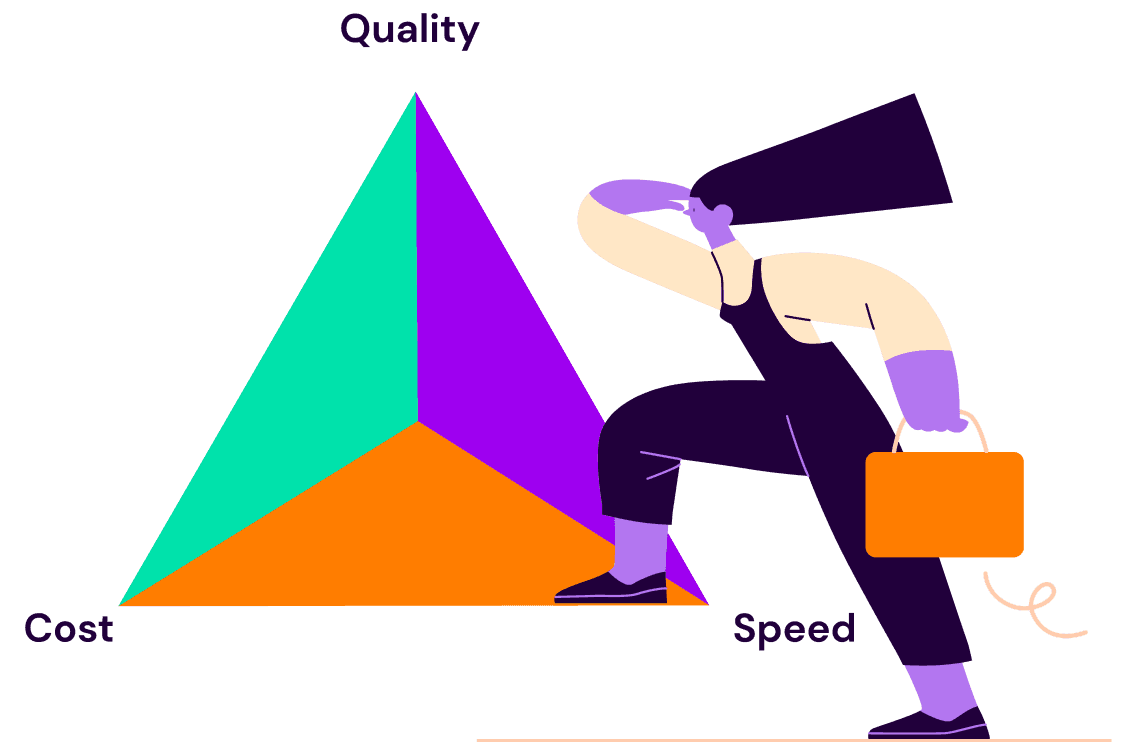
Back to blogs

5 Diversity Statistics that Will Shape Your Recruiting Strategy for 2018
With competition for top talent at an all-time high, you probably know that diversity hiring is one of the best ways to expand your candidate pool.
Think about it: focusing on skills and experience above race, religion, gender, age, sexual preference, or physical disability means you get a leg up on finding the best possible person for the job. Period. And that’s not even the best stuff: Diverse candidates open your business up to new perspectives, opportunities, and better connections to the communities you serve.
Oh, and did I mention diversity hiring makes your business more profitable, too?
That’s right—here’s the first diversity statistic for you:
#1. Companies with a diverse workforce are 35 percent more likely to outperform those without diversity initiatives
[Source: McKinsey]
I’m sure you intuitively understand that diversity hiring is a good thing. But seeing the actual impact really cements the idea that establishing a diverse workforce can have a dramatic impact on your business.
According to a study conducted by McKinsey, companies in the top 25 percent for gender diversity are 15 percent more likely to outperform companies in the lowest quartile. When looking at ethnic diversity, that gap expands to 35 percent.
Your action for 2018:
Start the conversation. If you’re in a leadership position at your company, sit down with your talent acquisition team to find out what you can do to target more diverse candidates. If you’re not in leadership, bring these statistics to your boss and make a case for why diversity hiring needs to become a bigger piece of your recruitment strategy.
#2. 72% of tech founders believe in the importance of diversity, but only 12% have five or more diverse employees in tech roles

Most tech companies recognize the importance of establishing a diverse workforce. But, there’s a clear gap between understanding and action.
As Techstars notes in their recent Diversity & Inclusion Report, many young tech companies struggle in finding the most cost-effective ways to attract and retain employees from underrepresented groups. Of course, sourcing tools that help recruiters identify diverse candidates are one simple solution. But, there are also larger initiatives at work to help organizations with a commitment to diversity hiring succeed.
Organizations like Tech Inclusion and Paradigm for Parity are working to improve access to diverse candidates for forward-thinking companies around the world. And it’s working: this next diversity statistic demonstrates that we’re taking steps in the right direction.
Your action for 2018:
Get involved with organizations like Tech Inclusion and Paradigm for Parity. Research the tools and strategies diversity leaders leverage to promote a more diverse workforce at their companies. Turn ideas into action in 2018.
#3. 70+ companies published gender diversity hiring targets in 2017
[Source: Forbes]
If last year was any indication of the way diversity hiring is headed, 2018 should be an exciting year, particularly when it comes to elevating women in the workplace. According to Forbes, there are now 70+ companies across all industries that made pledges to gender diversity hiring in 2017. Here are some highlights:
AOL set the goal of women making up half of their leadership team by 2020
Twitter upped their diversity hiring targets in all categories (including women in tech roles and women in leadership) after some big success in meeting 2016’s goals
BHP Billiton—the world’s top mining company—wants women to comprise 50 percent of its entire workforce by 2025
Of course, these are just goals—not quotas. There’s no guarantee AOL, Twitter, or any of the other 70+ companies will actually hit these targets. But, as Georgene Huang, CEO of Fairygodboss puts it:
“Quantifiable goals, transparency and measurement are all important signals that an employer takes diversity seriously.”
And taking it seriously is a tremendous leap forward for diverse candidates.
Your action for 2018:
Based on these diversity statistics, set a goal for your own company’s diversity hiring in 2018. Publish it on your company blog, promote it on your social channels, and get the word out that your organization values diverse talent.
#4. 92 percent of tech founders know about unconscious biases in hiring. But, only 45 percent are doing anything about it
[Source: Techstar]
The average job opening receives 250 applications. And your average recruiter spends just six seconds reviewing each of those resumes. Crazy, right?
With numbers like that, even the most well-intentioned recruiter is likely to have some unconscious bias dictating who they move forward to an interview and who gets left behind.
(Think you’re immune to unconscious biases? Try out this test from Harvard and see how implicit biases exist even where you least expect them.)
The good news is that most companies recognize that. The bad news is, less than half of them are doing anything about it.
And that’s a big problem. As Christine Del Castillo explains it over on the Workable blog:
“Due to human nature, we’re all unintentionally biased and more skilled at hiring people who are similar to us. If we don’t put the right processes in place, bias can snowball into discriminating against qualified people and undermining diversity initiatives.”
There’s an interesting study that came out of Harvard and Princeton about unconscious bias in symphony orchestra auditions.
The study put auditioning players behind a screen so that they would be judged solely on their playing ability and not who they are.
The results? The screen increased the hiring of female players by 30 to 55 percent.
And while you may not be able to put a literal “screen” between you and the candidates you source, there are definitely some easy ways to reduce your unconscious bias in recruiting.
Case in point: SeekOut’s Bias Reducer Mode.
Recruiters searching the 100 million+ profiles within SeekOut have the option to hide information on a candidate’s profile that may reveal their gender, race, or ethnicity with the flip of a switch.
Toggle Bias Reducer at the top of the list of candidates.

Once you turn that on candidate profiles will now look like this:

We replaced profile photos with adorable, gender-ambiguous kittens. We abbreviated names down to the initials. And we dramatically reduced the opportunity for unconscious bias as you give each profile your standard six-second scan.
Your action for 2018:
Face the facts on unconscious bias: every talent acquisition leader needs to put defenses in place that give all candidates an equal opportunity regardless of their gender, race, ethnicity, religion, sexual preference, or disability. If you’re looking for a good place to start.
#5. Military veteran unemployment reached a historic low in 2016 of 5.1 percent. But even still, 74 percent of post-9/11 veterans believe a civilian candidate with the same work experience would get hired before them
[Source: Bureau of Labor and Statistics; iCIMS]
Military veterans face many of the same discriminatory biases that have historically plagued women and minorities in the workforce. And yet, until very recently, veterans weren’t often a part of diversity hiring initiatives.
In 2011, the unemployment rate for post-9/11 veterans was 12.1 percent. Luckily, that number has dropped dramatically on the back of veteran hiring initiatives from companies like:
Amazon, who pledged to hire 25,000 military veterans and their spouses by 2021
Starbucks, who made a similar pledge of 25,000 hires
by 2025
Sprint, who joined forces with 50 other U.S. telecommunications companies in
[For a full list of the 25 best companies for veteran hiring, check out this blog post from Diversity Journal.]
However, despite initiatives from top companies and the dropping unemployment rate, many veterans still feel insecure about their post-service job prospects and the existence of negative biases in the recruitment processes of many companies.
A report from iCIMS showed that many veteran insecurities about getting hired center around a recruiter or hiring manager’s lack of understanding about their experience or how their military background translates into valuable skills in the workplace:

And according to Hiring Our Heroes—an initiative from the U.S. Chamber of Commerce Foundation — those fears aren’t entirely unfounded:
Only 9 percent of companies formally train recruiters and hiring managers on how to relate to military veterans in the hiring process.
And 49 percent of veterans said they have experienced bias in a hiring process before.
Your action for 2018:
Include veterans as part of your diversity hiring initiatives and implement specialized training on how to understand military experience and relate to veterans with your recruiting team.
Now it’s your turn:
These five diversity statistics should help give you an idea of the current landscape for diversity hiring. While many companies are doing great work in an effort to increase the number of diverse candidates in their recruitment pipeline, there’s still a lot of work to be done. What are your diversity initiatives for 2018?
Sources:
“Why diversity matters,” Mickinsey;
https://www.mckinsey.com/business-functions/organization/our-insights/why-diversity-matters
“Diversity and Inclusion in Technology,” Techstars;
“Seeking Women: 70+ Companies That Have Set Gender Diversity Targets,” Forbes;
“Employment Situation of Veterans,” Bureau of Labor and Statistics;
“The Veteran Hiring Report: What US Employers Need to Know” iCIMS;
See us in action
Learn how SeekOut unifies people data to help organizations reach their talent goals
Request a demo



